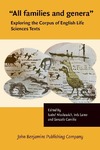Mostrar o rexistro simple do ítem
Linguistic indicators of persuasion in female authors in the Corpus of English Life Sciences Texts
| dc.contributor.author | Crespo, Begoña | |
| dc.date.accessioned | 2024-01-25T12:40:28Z | |
| dc.date.issued | 2021 | |
| dc.identifier.citation | Crespo, Begoña. 2021. “Linguistic indicators of persuasion in female authors in the Corpus of English Life Sciences Texts”. In Moskowich, Isabel; Lareo, Inés and Camiña Rioboó, Gonzalo (eds.), "All families and genera": Exploring the Corpus of English Life Sciences Texts. Amsterdam: John Benjamins. 148–167. | es_ES |
| dc.identifier.isbn | 9789027209245 | |
| dc.identifier.uri | http://hdl.handle.net/2183/35143 | |
| dc.description.abstract | [Abstract] In this work it is my aim to offer a description of the way in which women used linguistic devices denoting persuasion in samples that represent late Modern scientific writing, on the one hand, that is to say, samples from the Coruña Corpus of English Scientific Writing, and introductory material to these works, such as prefaces or dedications, on the other. Whilst scientific writing is considered to be presented in a neutral tone indicating objectivity and rigourousness (what in Lakoff’s words is known as “considerate styles”), prefaces can be said to evince a somewhat more intimate and persuasive tone (“high-involvement styles”) as, in principle, the stuctural rhetoric of these texts allows for a direct relationship between author and target readership. The features denoting persuasion, argumentation and interaction that will be analysed include predictive and necessity modals, conditional subordination and suasive verbs, infinitives, and split auxiliaries, considered as such by Biber 1988, Prelli, 1989 or Mischke, 2005, among others. Several variables will be taken into account in the present study: the diachronic variable (eighteenth, nineteenth centuries) and the communicative format variable, also known as genre (treatise, textbook, catalogue…). This analysis will allow me to unveil how frequently and under what discursive circumstances female writers were present in their works as well as the kind of linguistic devices they preferred and how this could be interpreted in terms of writing style. Hopefully, the data found will shed some light on the type of social role prevailing for these writers: that of scientists or that of eighteenth- or nineteenth-century women living in an androcentric society. | es_ES |
| dc.language.iso | eng | es_ES |
| dc.publisher | John Benjamins | es_ES |
| dc.relation.uri | https://doi.org/10.1075/z.237.08cre | es_ES |
| dc.subject | Late Modern scientific English | es_ES |
| dc.subject | Prefaces | es_ES |
| dc.subject | Coruña Corpus | es_ES |
| dc.subject | Persuasion | es_ES |
| dc.subject | Female writing | es_ES |
| dc.subject | Corpus of English Life sciences Texts (CELiST) | es_ES |
| dc.title | Linguistic indicators of persuasion in female authors in the Corpus of English Life Sciences Texts | es_ES |
| dc.type | info:eu-repo/semantics/bookPart | es_ES |
| dc.rights.access | info:eu-repo/semantics/embargoedAccess | es_ES |
| dc.date.embargoEndDate | 9999-99-99 | es_ES |
| dc.date.embargoLift | 9999-99-99 | |
| UDC.startPage | 148 | es_ES |
| UDC.endPage | 167 | es_ES |






